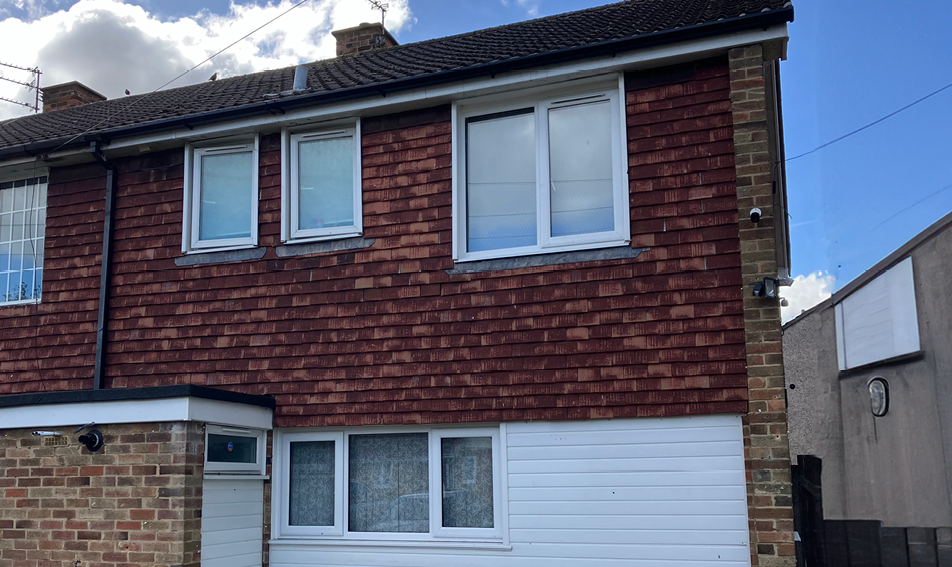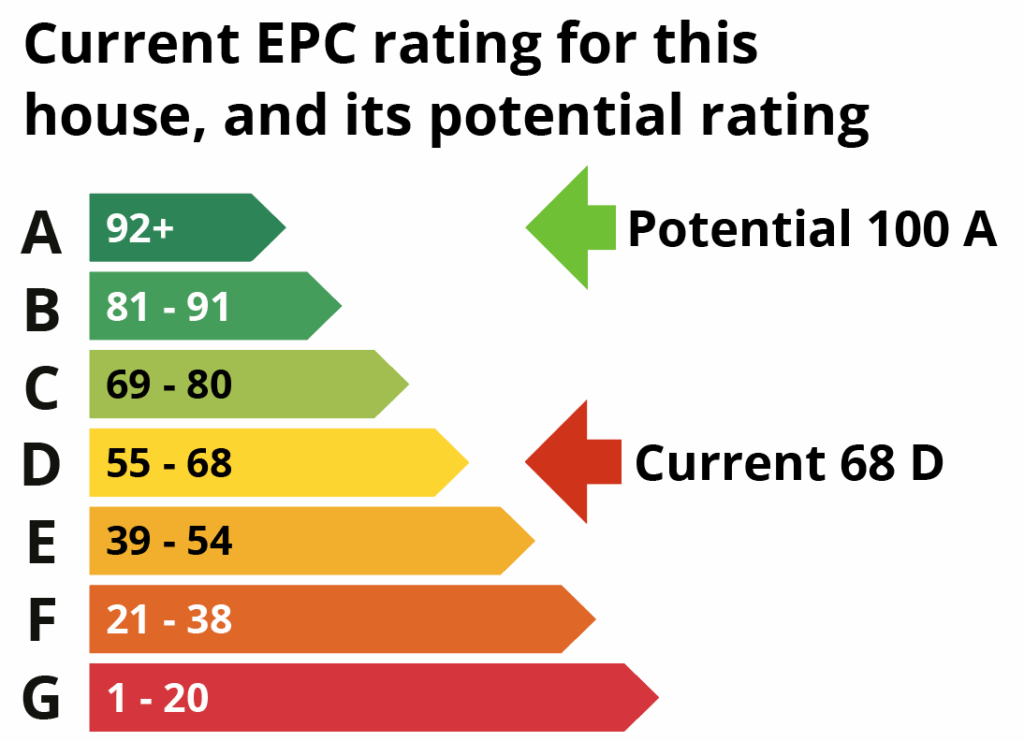
1950s end-terrace rental property in Oxford
Could your letting property be made warmer, cheaper to run, and better for the planet? See what’s possible when you take a whole-home approach to planning energy upgrades.
What’s the potential of a rental property like this?
This 1950s end-terrace in Blackbird Leys, Oxford, is typical of many post-war homes, with mostly cavity walls, some solid sections, and solid concrete floors.

The landlord wanted to improve the EPC rating, reduce running costs, and make the home cheaper for tenants to live in. With a Whole House Plan, she could see which upgrades mattered most and how to phase them over time.
Here’s what the plan revealed:
| Carbon emissions could be cut by over 90% |
| The EPC rating could rise from 62 D to 100 A |
| Annual fuel bills could drop from £1,551 to almost nothing |
You don’t have to carry out every measure at once. The Whole House Plan gives you a roadmap so you can make improvements in your own time, at your own pace, and within your budget.

“I want to improve the energy efficiency of the house to raise its EPC rating and prevent deterioration. But I’m also keen to reduce fuel bills for my tenants, making it cheaper and more comfortable for them to live in.”
Donna, landlord, Blackbird Leys, Oxford
Where this property stands now
House profile
| EPC rating | Current 68 D > Potential 100 A |
| Type | Semi-detached |
| Built | 1950s |
| Location | Blackbird Leys, Oxford |
| Occupancy | Tenants |
| Bedrooms | 3 |
| Floor area | 87m² |
| Walls | Mostly cavity, some solid |
| Floors | Solid concrete |
| Roof | Pitched with loft |
| Windows | uPVC double glazed |
| Annual energy use | 14,478 kWh (167 kWh/m²) |
| Carbon emissions | 3.0 tonnes CO2/year |
The EPC rating: now vs potential

An EPC rates your home’s energy efficiency – from A (best) to G (worst). A higher score can mean lower bills, but it doesn’t guarantee comfort. Whole-home upgrades help bridge that gap.
Long-term comfort, short-term disruption
| Key to tables: | Low impact: • | High impact: •••••• |
| Minor measures | Comfort & health | Disruption |
|---|---|---|
| Low energy lighting | ● | ● |
| Insulate and draught-proof loft hatch | ●●●● | ● |
| Cavity wall insulation | ●●●●● | ●● |
| Increase loft insulation to 300mm | ●●●● | ●● |
| Insulate flat roof of single-storey extension | ●●●● | ●● |
| New insulated front door | ●●●●● | ●● |
| Ventilation improvements | ●●●●●● | ●● |
| Major measures | Comfort & health | Disruption |
|---|---|---|
| External wall insulation | ●●●●● | ●●● |
| Solid floor insulation | ●●●●● | ●●●●●● |
| New double or triple glazed uPVC windows | ●●●●●● | ●●●● |
| Air source heat pump | ●●●●●● | ●●●● |
| Measure | Comfort & health | Disruption |
|---|---|---|
| Solar PV | ● | ●● |
Expert tip

“Often houses might only have 100mm of loft insulation, but 300mm is recommended. If you or your tenants store things in the loft, consider a loft boarding system to avoid compressing the insulation and losing its effectiveness. You should also check that the loft space is properly ventilated so that moisture doesn’t build up and rot the roof timbers.”
Geordie Stewart, Scheme Manager
The difference each step could make
These figures show how each recommended measure could affect the home’s EPC rating, energy bills, and carbon emissions – if installed in the order shown. They’re based on a full Whole House Plan tailored to this property.
| Measure | Est. cost | EPC | Fuel bill | CO₂/year |
|---|---|---|---|---|
| Where you are now | – | 68 D | £1,291 | 3.00 t |
| Increase loft insulation | £1.5k–£2k | 69 C | £1,269 | 2.94 t |
| Cavity wall insulation | £1.25k–£1.75k | 72 C | £1,120 | 2.51 t |
| Ventilation improvements | £1.5k–£2.5k | 72 C | £1,120 | 2.51 t |
| External wall insulation (100mm) | £15k–£17.5k | 74 C | £1,032 | 2.26 t |
| External insulation to non-cavity walls | £7.5k–£10k | 77 C | £904 | 1.90 t |
| Insulate flat roof of extension | £2.5k–£3.5k | 77 C | £893 | 1.87 t |
| Solid floor insulation | £8k–£12.5k | 78 C | £837 | 1.71 t |
| New insulated front door | £2k–£3k | 78 C | £826 | 1.68 t |
| Triple glazed uPVC windows | £10k–£15k | 79 C | £777 | 1.55 t |
| Air source heat pump | £13.5k–£17.5k | 86 B | £647 | 0.31 t |
| Solar PV (4 kWp) | £5.5k–£7.5k | 100 A | £0 | 0.00 t |
Boost your EPC rating
Installing a single major system like a heat pump or solar panels can still make a big difference. These examples show how individual upgrades could shift the home’s EPC and reduce carbon emissions – even before doing everything else.
| Upgrade option | EPC rating | Fuel bill | CO₂ emissions |
|---|---|---|---|
| Just solar PV | 91 B | £446 | 2.05 t |
| Just heat pump | 75 C | £1,137 | 0.54 t |
| Solar + heat pump | 94 A | £424 | 0.07 t |
Expert tip

“The walls of this property are mainly cavity, but the first floor walls at the front and back are solid (with hung wall tiles). External Wall Insulation can be applied to both cavity and solid walls which will reduce fuel bills and improve airtightness. It’s also not too disruptive for tenants as all of the work is external.”
Natasha Ginks, Retrofit Coordinator
Wondering what’s right for your home?
A Whole House Plan gives you expert, independent advice on the best steps to take – and in what order – so every upgrade really works.
Don’t put it off another year. Take the first step with a free consultation. Our team of experienced Retrofit Advisers will listen to your goals, help you understand what’s possible, and outline the best next steps – no pressure, no obligation.
Smarter home upgrades. Backed by trusted retrofit expertise.

A partnership project
A House Like Mine is an Oxford City Council initiative, delivered as part of the Zero Carbon Oxford Partnership (ZCOP) in collaboration with Cosy Homes Oxfordshire. The idea was first developed through case studies in Charlbury, and has since been expanded to show what’s possible for homes across Oxford and Oxfordshire.
It’s designed to help you take the first step towards making your home cosy, energy-efficient, and ready for the future. Step by step.
A House Like Mine was funded by the MCS Foundation, Oxfordshire County Council, Oxford City Council, and Lucy Group. The case studies are licensed under a Creative Commons BY-NC-ND 4.0 licence (creativecommons.org).

Prefer a PDF version?
Download a shareable PDF of this case study – perfect for your community group, local class, or anyone curious about improving home energy efficiency.
We’re making this resource freely available to raise awareness of how retrofitting – upgrading your home to use less energy and stay comfortable year-round – can make a real difference.
Click here to download the PDF
